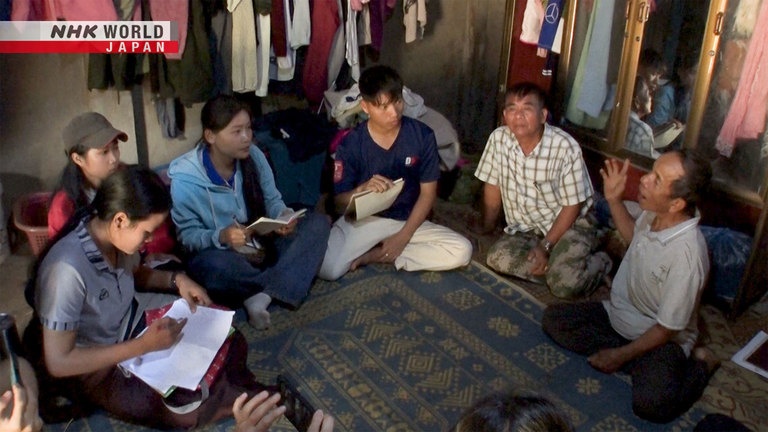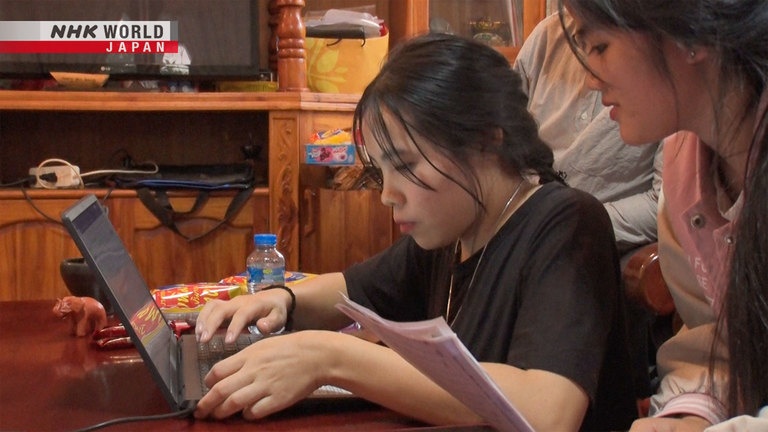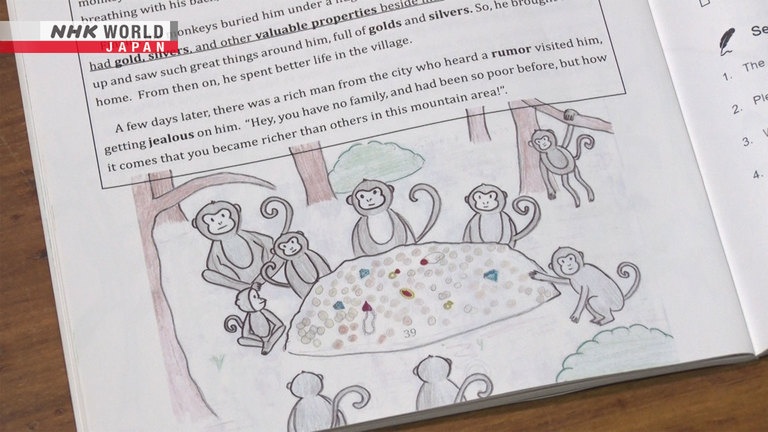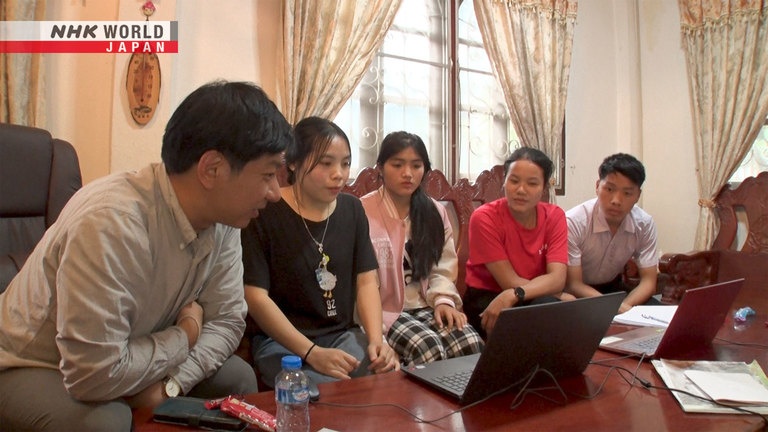Folk Tales for a New Generation: Laos
In Laos, young members of ethnic minority groups preserve folk tales as picture books and learn essential skills as they go. The project, led by Yokoyama Taizo, gives them control over their future.




Transcript
Laos is a landlocked country in southeast Asia.
It is known for its natural abundance and long-established ways of life.
Around 50 ethnic minority groups make up half the population.
Each one preserves its own language and traditional customs.
But today, many young people from these communities move away to urban areas.
And this puts village culture at risk.
Young people have fewer chances
to master our cultural heritage.
They're heavily influenced
by outside culture.
We're going to focus on a project that tackles these issues.
It supports young ethnic minorities in urban areas and preserves their traditions.
A key figure in the initiative is Yokoyama Taizo, from Japan.
The project involves having young members of minority groups study oral traditions in villages.
Many communities do not have a written language.
"You desecrated my father's grave!"
"You're going to pay for this."
Participants translate these stories into Lao and then English, and preserve them as picture books.
This builds new relationships, and develops computer and language skills that will be useful for work.
I want participants to learn about
their roots and build confidence.
It's interesting to combine skill
development and cultural preservation.
Our project is evolving into
something unconventional.
This time, we examine this project that's helping young people,
preserving their culture, and giving them the power to forge their own future.
Luang Prabang is the ancient capital of Laos.
The streets are lined with temples, and many tourists visit.
The city in its entirety is a World Heritage Site.
Many young members of minority groups come here from their villages, seeking work and education.
These young women offer an example. They live together.
They came with the assistance of friends and relatives.
But life in the city is not easy.
I used to work at a restaurant.
There was a lot of unpaid overtime.
And the wages were low.
Many young people in villages do not receive a full education.
They resign themselves to low-paying jobs, and cannot pursue their dreams.
These three high-school students are using the power of folk tales to help them.
I want to try new things,
and learn a lot.
That's why I'm taking part.
Yokoyama picks them up.
Hello!
Their destination is Lak Sip, a village of the Khmu people.
Today's participants include students from the Khmu, Hmong, and other groups.
So the village we're visiting is known
for a particular characteristic.
The people are knowledgeable
about Khmu history and folklore.
Hello.
First, Yokoyama greets the village head, who has come to welcome the group.
The youth follow modern trends.
Only the elderly protect our customs.
So I'm happy this group is taking
an interest in our people.
The village head has arranged for a knowledgeable resident to guide the group.
Lak Sip hasn't always existed.
Several ethnic groups gathered
to form the village.
People came from the highlands,
the lowlands, and the midlands.
Together, they created
this large community.
They begin with an explanation of the origin of Lak Sip.
Then the guide takes the group to the home of Siengbaow, a man following a traditional lifestyle.
This is the stove.
This is a Khmu hat,
for use in the fields.
And this is for rubbing
ointment on your arm.
You use it if you get injured.
While speaking to Siengbaow, the student takes pictures.
Yokoyama takes a back seat.
He prefers to let the students' curiosity guide them.
When I was their age, I didn't
have much passion for schoolwork.
But I enjoyed learning about
things that I found interesting.
So I want to spark their curiosity
through these experiences.
The main event comes at the end of the day.
It's time to listen to a folk tale.
"Once upon a time, a great change
came upon the mountains and land."
"The light of the sun disappeared."
"There was an extremely large tree.
Seven times as big as a mountain."
"People believed that felling the tree
would reveal the light."
"Two brothers, Chiang and Yee,
set out to undertake the task."
"They succeeded in cutting down the tree."
"Ever since, people have
paid tribute to those brothers."
"The Hmong and Khmu people
celebrate with a festival."
Tales like this, passed down orally, are recorded by the students.
They're preserving our stories.
I hope they pass them on
to the next generation.
I'm young, so I don't know
much about the old times.
I get to learn our history.
It's very moving.
Back at the project office, the students begin their next task.
We're translating the story into Lao.
"Felling the tree would reveal the light."
They listen to the Khmu story and write it down in the official language, Lao.
Then they create a digital version.
The students don't have much experience with computers, but this task gives them a chance to learn.
I want to keep going in order
to improve my skills.
And if I can get my own computer,
I'm sure I'll get even better.
Using online software, the story is translated from Lao to English.
It says, "old man."
Change this to "old people."
- Try it.
- Like this?
Led by members who speak English, they improve the text as best they can.
These skills will be useful
in their search for work.
The Lao and English languages.
Computer skills.
It's a natural way to learn.
That's a core element of this project.
The project is funded by a non-profit organization that looks after socially withdrawn young people in Japan.
Yokoyama co-founded it in 2009.
It encourages the socially withdrawn to participate in society
by enabling them to work remotely on web development for businesses and local governments.
I actually quit high school at one point.
I didn't feel comfortable
in Japanese society.
Lifestyles and viewpoints
should be diverse.
That offers a point of entry to those
who feel they've lost their way.
The organization expanded its support to young people abroad.
In 2018, it started working in Laos.
It offered free lessons in computer use and English.
But many young people disliked studying, and numbers declined.
A teenager's doodle offered a hint on how to proceed.
This is my workbook. Someone
doodled in it without asking.
I asked about the drawing. That was
my first encounter with minority culture.
They spoke about it with
such enthusiasm and confidence.
From there, we developed a project
about folk tales with the local people.
Yokoyama worked with someone who shared his goals:
Siphone Sengvandy, a member of the Khmu group.
He works in local government and supports the project's activities.
In the past, Siphone worked with a publisher on a folk tale picture book.
He realized this was an opportunity to help young people develop.
My grandmother used to tell stories.
That inspired me to publish a book.
Creating a book boosted Siphone's confidence.
We help young people learn
how to write and tell stories.
We provide tools, and so on.
This develops the skills of children
from minority groups.
Yokoyama and Siphone gathered interested participants from minority groups, and got the project going.
Since then, illustrated digital versions of 30 folk tales have been produced.
Here's one about Phaya Nak, a serpent deity revered in Laos and Thailand.
Long ago, animals were disappearing, and bones were found in a large burrow.
The villagers found many snakes there, which they caught and ate.
Among them was Phaya Nak.
Phaya Nak caused a flood that swept the village away, along the Mekong River.
The story was illustrated by Theng Thor, of the Hmong people.
The project helped him realize how valuable his drawing ability was.
Contributing to the project qualifies people for financial support.
They can use the money to buy shoes and clothes, or pay study fees.
I can send money back to my village.
And items I buy in the city.
That really helps them out.
The support Theng received included this art set.
I can add color to black and white
drawings like this.
Since receiving the art set,
I've been doing a lot of practice.
I have an ambition.
After high school, I want to
study somewhere interesting.
Maybe abroad, rather than here.
Somewhere I can study art.
Phengvanh, of the Khmu group, leads the folk tale study trip.
She left her village and found manual work.
But she wanted to improve her English, so she joined the project.
She now works as an assistant to Yokoyama.
Discovering new things
is very exciting.
I learn about culture through teamwork,
and experience professional life.
Phengvanh decided to join an IT class to improve her ability with computers.
I want to learn these skills
so I can teach them to others.
That's my mission.
The project is helping young people work toward their dreams and personal goals.
They also visit the home villages of participants.
Today, Souk Suda is travelling to her birthplace, in the mountains.
It's three hours from Luang Prabang by car.
Souk grew up in this natural environment with its hills and river.
She's one of many young people who left to make a living.
I thought that making money in the
city would improve my life. It didn't.
It was harder than I thought.
I wanted to study, but couldn't.
I quit school to find a job,
so I could support my parents.
A reunion with her family.
Her little sister is getting bigger.
It's been a year since she's seen her mother.
This house belongs to Souk's grandfather.
When she was young, he would often tell scary stories, and he shared one with us.
"He set a rope trap."
"The next day, he saw that
he'd caught an evil creature."
"'You desecrated my father's grave!'"
"'You wretch!
You're going to pay for this.'"
"The creature begged for forgiveness."
Souk's grandfather's eyesight is declining.
But his stories have lost none of their power.
I'm happy to tell stories
to my granddaughter.
One day, I hope she passes them
on to her children.
You can't preserve stories alone.
You need other people's help.
His stories make me as happy
as when I was a child.
The project gives young people the chance to get in touch with their roots.
The organizers hope to collaborate with a local university.
Today, Yokoyama and Phengvanh are visiting to discuss future activities.
They meet with an English teacher, and a Lao teacher.
The research that I want to do...
We focus on themes and topics.
For example, ceremonies.
There are many ethnic groups in Laos.
My people rely on spoken language.
They transmit it from generation to generation.
I think this generation maybe don't know about our dialects.
We have students from groups
such as the Khmu and Hmong.
Taking part in this project
improves their skills.
Yokoyama seeks advice about a publication produced by the project.
It's an English textbook.
It uses illustrated folk tales to teach reading comprehension, while sharing cultural information.
Students from minority groups don't
often speak about their culture.
They're embarrassed by it.
This teaching method may nurture
confidence and pride.
Collaborating with a university may help the project grow.
Once a week, there's an evening activity.
The venue is the metaverse.
Participants take part using digital avatars.
Some of them are young Japanese people who enjoy opportunities to speak English.
Hello, my name is Chanhsouk.
I am from Nong Chong village.
I study at Naluang school.
Participants from Laos share documents they translated into English, and everyone checks them together.
Japanese participants ask questions about the content.
There is a "big ladle spoon" in paragraph four.
And I wonder what happened to the spoon after the paragraph. Like, how it went.
It's very difficult to say this. But finally they don't know about this spoon.
So where is it? They don't know.
Speaking English with people from elsewhere brings the students closer to their dreams.
Luang Prabang has many hotels
catering to foreigners.
In the future, I'd love to work
in the hotel industry.
It's late December.
Yokoyama goes with the group to a Khmu village.
It's the day of an annual festival.
Many villagers work hard to preserve their traditions.
The event has even attracted foreign visitors.
Yokoyama's group was invited thanks to connections built through their work.
The village head is a big supporter of the project.
At the festival, prayers are offered to Khmu spirits and deities.
Onlookers are entertained by young dancers.
Other performances involve bamboo, which is an essential material in daily life.
The project participants are also going to perform.
In the local language, they tell a story about rang ron, a flower used in Khmu rituals.
"Two parents, two siblings, and
a stepsister lived together."
"Moo! Moo!"
"The stepsister heard a water buffalo,
and went to the river to investigate."
They then perform it in English.
Her husband took a knife to kill the buffalo.
After, the buffalo died.
He went so long and then he saw the river.
He threw the meat, and it landed and there were so many beautiful flowers.
Those flowers were rang ron. Thank you.
This was a new experience.
It expanded my horizons.
It was a rare opportunity to
showcase my own culture.
I felt so proud. Even some locals
didn't know that story.
Grandparents usually tell stories,
but now it's the children's turn.
The event was such a success that the village began a new initiative with the project.
They set up a study tour to introduce students and tourists to village culture.
This allows visitors to experience what they hear in folk tales:
Laos' natural beauty, and the peaceful lives of its people.
When your book of folk tales is ready,
I'd like her to take charge.
I hope she can visit schools,
and spend an hour telling stories.
Good luck!
Older people hope the young generation will take the lead in preserving tradition.
As globalization progresses,
everything is becoming standardized.
That brings prosperity,
but psychologically, there are issues.
Combining technology and tradition
can create something of value.
I think we should prioritize
spiritual wealth over material wealth.
And I hope that young people
build on that idea.
This project allows people to protect endangered cultures.
It cultivates confidence and pride in young people from minority groups.
And it builds skills that will help them fulfil their ambitions.
The goal is for young people to transcend boundaries of age and social identity,
and -- together -- build a better future.